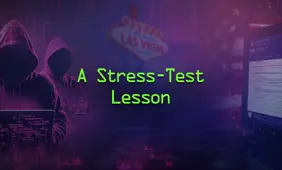Inside the World of Casino Scam Tools and the Tech That Powers Them

We’ve explored how technology has evolved to become a constant threat to casinos and an occasional threat to players (from other players). However, evolution works in multiple directions, with only the most successful methods evolving further – at least that’s the theory. In reality, technology-based cheating is a thriving petri dish of deception, where all manner of ridiculous ideas are tested by clumsy, often inexperienced, cheaters high on new concepts, but, like a virus, any successful method can be quickly replicated, spread, and adapted from one end of the globe to the other in the blink of an eye.
Recently, while visiting a secret collection of crooked gaming equipment, I was with a magician friend who was thrilled by each gizmo and doo-dad displayed in tall glass cabinets. However, after being shown a beautifully curated selection of advanced and ingenious tools used by cheaters, the item that caught his eye and fired his imagination was a small tobacco pipe with a mirror inside!
The pipe shiner is a staple of old gambling catalogs and exposés, never failing to impress people because its purpose is immediately obvious and easy to appreciate. In contrast, the many devices surrounding this old prop require more knowledge to both use and understand the danger they present.
It’s a common problem when trying to illustrate how even the slightest thumb on the scale of a gambling game can shift all of the odds against honest players. Professional, bespoke devices tend to do so both cleverly and carefully (though there are exceptions) and are sometimes counter-intuitive, so even seasoned gaming professionals struggle to recognize their significance.
When a Single Gadget Changes the Game
We’ve previously discussed the player who seemingly entered “God Mode” while playing in a streamed live game using RFID technology to convey cards to the stream. That player was constantly looking at his phone, and his efforts to do so surreptitiously became almost comical. Yet, the live commentators of those games failed to recognize the significance of his actions for many hours.
In that case, it appeared that live card data, which was supposed to be stored and delayed for thirty minutes, had somehow been relayed to that player’s phone. However, that seemed to mark the end of his attempt at deception, as all he did at the table was stare into his lap while his phone illuminated his face!
So, how would a more skilled cheater approach this problem? The answer lies in one of the essential principles of expert cheating: be natural.
The Rule Every Expert Cheater Follows
Many magicians have adopted this rule thanks to the teachings of Dai Vernon, a Canadian magician who moved to America in the early 20th century and became a central figure in the emerging art of close-up magic, incorporating many techniques and principles from the world of cheaters. Being natural was a radical, transformative notion compared to the more theatrical style of physical performance typical of the time. Miracle effects became more intimate and personal, and accessible yet complex sleight of hand was adapted to this framework, along with misdirection and timing.
Magic methods soon began to catch the interest of cheaters, and while it remains rare for techniques to merge perfectly in both forms, false shuffles, deals, palms, and shifts were often traded between the worlds of crooked gambling and magic performance.
Vernon was essentially a bridge between these worlds, gaining the respect (and the methods) of both cheaters and magicians. However, on one occasion, he found himself struggling to pry a particularly powerful technique from a mechanic who refused to reveal his secret. After many hours of demonstrating sleights, Vernon decided to retire for the evening.
As the two men parted, the cheater offered a glimmer of hope. While he was impressed by Vernon’s catalog of moves, what he really needed was a way to move a card from his left palm to his right palm without using the standard hand-washing action, which he felt most 'stumps' would recognize. If Vernon had something that would work in a game, it might make the perfect trade for the secret he sought.
So, the Professor (Vernon’s moniker in later years) returned to his hotel and spent many hours trying to engineer an unnoticeable transfer of a playing card from one hand to another. However, in every example, the required action was unnatural and likely to attract attention. Finally, he could fight sleep no longer and checked his watch – at that instant, he realized he had stumbled upon the answer.
Vernon’s solution was to have the card palmed in his left hand while the right hand grasped the left in the familiar action of checking the time on one’s wristwatch. This placed the right hand over the left, allowing the card hidden there to be slid into the right hand as it withdrew! The action made the move undetectable, as it was so common that no one would suspect, let alone detect, the sleight!
From Magic Sleights to Table Fraud
As it turns out, cheaters have applied the same approach to accessing visual information on a digital device, with results varying from risky and complicated to simple and ingenious. In this case, no RFID table or playing cards are required. The game is poker, but similar solutions might be applied to Blackjack or other games where hidden cards or information could be valuable.
As described to me, the method involved a phone placed on the table with the camera pointing upwards. However, the phone’s case was somewhat unusual, and what attracted the attention of security was that the device seemed to be returned to the same spot every time and was always on the table during a specific moment in the game. As it turns out, the dealer was working with the player to flash cards from one round of play and then deal them into the flop, turn, and river in the next round. This is a classic collusion tactic, and it raises questions about the thin line between deception and cheating in poker.
Typically, this is an old-school cheating method that requires the player to look in the right direction while the dealer gathers cards after a round, so two or three of those cards can be tilted just enough – flashed – for their confederate to see. The deck is then shuffled, but the required cards remain in position to fall as desired.
The phone had been adapted to include a high-quality pinhole camera built into the edge of the device, and when aimed at the dealer, the cards needed to be raised very little to get enough light for the camera to see their value. This image was then sent to the player’s smartwatch after a small delay.
To avoid constantly raising their hand and staring at their wrist, the player crossed their arms and placed their chips close to the edge of the table, allowing them to appear to look down at their chips while actually glancing at their watch, which was shielded by the arm crossed in front. This approach concealed the watch screen from above and around the player, while the body language excused the physical actions required for the glimpse.
The problem was not that the player was unnatural, but that their actions were uniform and lacked variety, eventually attracting the attention of watchful security, who, as I understood it, were already suspicious of their dealer. Once they began watching closely, seemingly natural actions quickly became identifiable, much like spotting a snow leopard in a predominantly white landscape; hard to spot but impossible to miss once you know it’s there.
In the end, this method belongs beside that old pipe in a glass cabinet, but that doesn’t mean it won’t return in another form as consumer electronics continue to be tested at tables around the world; eventually, something will work and become immensely valuable to cheaters willing to accept the risk.
Where Cheating Goes Next
Consider how small devices and screens have evolved over the last couple of decades, where sneak peek cameras that were once hidden in air conditioning ducts have become small enough to be built into chip trays, then cell phones, watches, and even chips themselves might contain an invisible eye ready to provide an unfair advantage. In fact, I’ve already seen hollowed-out stacks of chips containing cameras (plural – I’ll leave you to guess why), processors, and transmitters that do not require the dealer’s help and use a combination of electronic transmission with physical signals to further conceal the deception.
If it can be conceived, it can be built and tested, and like it or not, the primary target for prototyping new cheating methods is where the cheaters feel safest; therefore, fellow players are often the targe
Likely? No.
Possible? Absolutely.
The lesson is simple: while the truly impressive devices require a trained eye to fully grasp their effectiveness, there’s always a new pipe with a mirror inside.





Review this Blog
Leave a Comment
User Comments
comments for Inside the World of Casino Scam Tools and the Tech That Powers Them